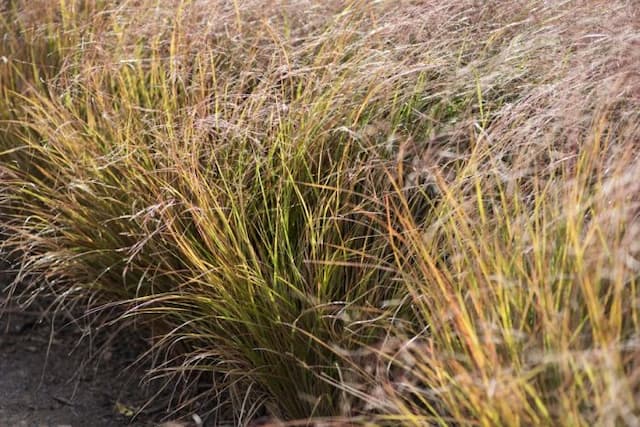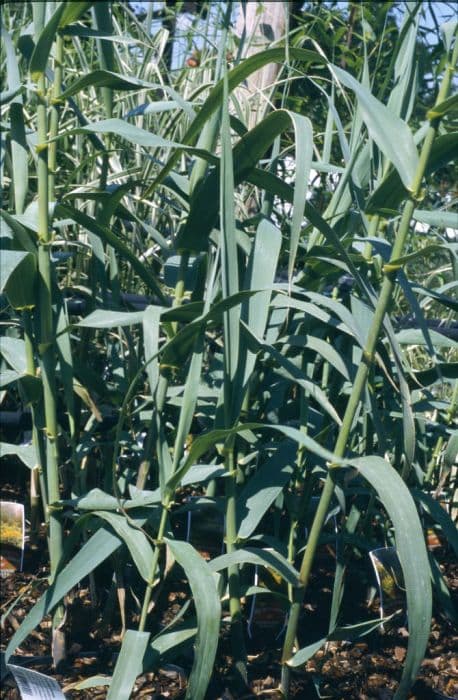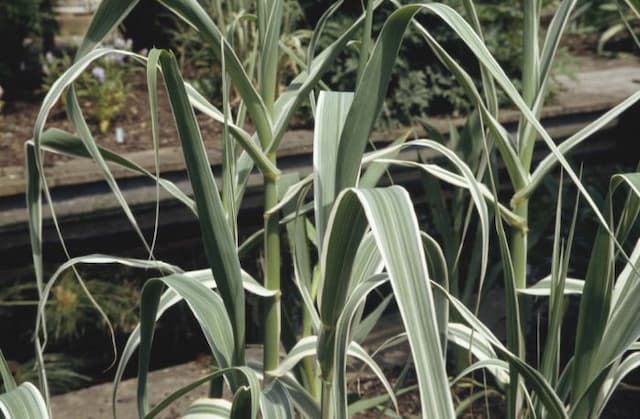Siberian Melic Melica altissima 'Atropurpurea'

ABOUT
Melica altissima 'Atropurpurea', commonly known as the Purple Wood Melic, is a visually striking ornamental grass known for its aesthetic appeal in gardens and landscapes. This plant showcases slender, arching leaves that create a delicate, cascading effect. The foliage is a rich green color, providing a lush backdrop for the standout feature of this variety: its purplish-brown flower spikes. These flower spikes emerge in the late spring to early summer, adding a soft, yet dramatic burst of color to the plant's profile. The Purple Wood Melic's flowers are airy and feathery, forming elongated clusters on top of slender, upright stems that rise gracefully above the foliage. The inflorescences possess an ethereal quality, catching the light and swaying gently with the breeze. This subtle movement adds to the plant's charm and can create a tranquil, whimsical ambiance in the garden. As the season progresses, the flowers mature and may take on a more buff or beige tone, providing continued visual interest well into the fall. These dried flower spikes can also be left on the plant for winter interest, adding texture to the dormant garden landscape. The Purple Wood Melic's overall form is a clumping habit, which means it grows in a neat, mounded shape that stays relatively contained. This quality makes it an excellent choice for planting in groups or as a specimen in smaller garden spaces where a tidy appearance is desired. The combination of its elegant leaf blades and the distinctive coloration of its flower spikes makes the Purple Wood Melic a sought-after addition for those seeking to enhance the beauty and diversity of their garden spaces with ornamental grasses.
About this plant
 Names
NamesFamily
Poaceae
Synonyms
Tall Melic, Purple Melic Grass, Siberian Melic Grass
Common names
Melica altissima 'Atropurpurea'.
 Toxicity
ToxicityTo humans
Purple wood melic (Melica altissima 'Atropurpurea') is not widely recognized as a toxic plant to humans. There is no well-documented evidence to suggest that consuming or coming into contact with this ornamental grass will lead to significant poisoning or adverse health effects. As with many plants, individual sensitivities vary, and it's always best to avoid ingesting plants that are not specifically meant for human consumption.
To pets
Purple wood melic is not widely known to be toxic to pets. There is limited information suggesting that animals, such as dogs, cats, or other domestic pets, would exhibit symptoms of poisoning upon ingesting this grass-like plant. However, as with any non-food plant, it is generally wise to prevent pets from consuming it as a precaution, since individual animals might have sensitivities or allergic reactions to plants not part of their typical diet.
 Characteristics
CharacteristicsLife cycle
Perennials
Foliage type
Deciduous
Color of leaves
Green
Flower color
Purple
Height
3-4 feet (90-120 cm)
Spread
1-2 feet (30-60 cm)
Plant type
Herb
Hardiness zones
5
Native area
Europe
Benefits
 General Benefits
General Benefits- Ornamental Appeal: The plant's purple-tinged flowers and foliage add aesthetic value to gardens and landscapes.
- Low Maintenance: It requires minimal care once established, making it suitable for busy gardeners.
- Drought Tolerant: Once established, it can withstand periods of low water availability.
- Erosion Control: Its root system can help stabilize soil and prevent erosion on slopes.
- Wildlife Habitat: It can provide food and cover for birds and other wildlife.
- Cool Season Growth: Thrives in cooler temperatures, making it ideal for early season interest in the garden.
- Tolerates Various Soil Types: It can adapt to a range of soil conditions, from clay to loam.
 Medical Properties
Medical PropertiesThis plant is not used for medical purposes.
 Air-purifying Qualities
Air-purifying QualitiesThis plant is not specifically known for air purifying qualities.
 Other Uses
Other Uses- Artistic Inspiration: The striking purple color of Melica altissima 'Atropurpurea' spikes can be a muse for artists and photographers, serving as a unique subject for color and texture studies.
- Privacy Screening: Due to its height, this grass can be planted in rows to create a semi-transparent, natural screen that provides some privacy in gardens without completely blocking views.
- Dried Flower Arrangements: The inflorescences of Melica altissima 'Atropurpurea' can be dried and used in long-lasting floral arrangements, adding height and a touch of natural elegance.
- Landscape Texturizing: This ornamental grass is perfect for adding texture contrast in landscape designs featuring smooth-leaved plants, thereby enhancing overall visual appeal.
- Erosion Control: The root system of Melica altissima 'Atropurpurea' can help to stabilize soil on slopes and prevent erosion in areas prone to losing topsoil.
- Winter Garden Interest: As the grasses maintain their structure in winter, they offer visual interest in otherwise barren gardens during the colder months.
- Crafts and Decorations: The tall, colorful spikes can be incorporated into crafts and rustic home decorations, such as making wreaths and wall hangings.
- Swishing Sound Effect: When planted in groups, the gentle rustling noise the leaves make in the wind can create a soothing auditory experience in the garden.
- Theme Gardens: Melica altissima 'Atropurpurea' can be used in moon gardens where its foliage can catch the moonlight and add to the nighttime ambiance.
- Educational Tool: This plant can be used as a teaching aid for botany enthusiasts to learn about plant structure, growth patterns, and lifecycle of perennial grasses.
Interesting Facts
 Feng Shui
Feng ShuiThe Purple Moor Grass is not used in Feng Shui practice.
 Zodiac Sign Compitability
Zodiac Sign CompitabilityThe Purple Moor Grass is not used in astrology practice.
 Plant Symbolism
Plant Symbolism- Purple Wood Grass: The cultivar name 'Atropurpurea' references the deep purple coloration which can symbolize royalty, nobility, luxury, power, and ambition, hinting at the plant's regal appearance and dignified stature.
- Gracefulness: Melica altissima is known for its tall and elegant stems, which can represent grace and beauty. This symbolism comes from the plant's graceful sway in the breeze, which can be calming and aesthetically pleasing.
- Resilience: Being a hardy perennial, this plant can symbolize endurance and the ability to thrive in various conditions, reflecting resilience in the face of life's challenges.
- Harmony with Nature: As a natural grass, it often symbolizes a connection to the earth and the importance of living in harmony with the surrounding environment, highlighting the importance of ecological balance.
 Water
WaterThe Purple Wood Grass should be watered deeply, allowing the soil to dry out slightly between waterings. Ideally, you should provide about 1 inch of water per week during the growing season. Overhead watering or using a soaker hose early in the day is effective, helping to ensure that the foliage doesn't stay wet into the night, which can promote fungal diseases. During hot, dry spells, you may need to water twice a week, while in cooler weather or if rain is frequent, reduce the watering accordingly. Always check the soil moisture level to determine if additional water is needed, as overwatering can be detrimental.
 Light
LightThe Purple Wood Grass thrives best in full sun to partial shade. It prefers at least 6 hours of sunlight a day but can tolerate some shade, especially in the afternoon when the sun is most intense. An ideal spot would be one where it can bask in the morning sun and then receive filtered light as the day progresses. Avoid deeply shaded areas as this can lead to poor growth and less vigorous plants.
 Temperature
TemperaturePurple Wood Grass is hardy and tolerates a range of temperatures but grows best in conditions where the temperatures are between 60°F and 75°F. It can survive minimum temperatures down to about -20°F and maximum temperatures up to around 90°F. The plant is resilient to temperature fluctuations within this range but may need protection if extremes persist for long periods.
 Pruning
PruningPruning Purple Wood Grass involves cutting back the foliage to ground level in late winter or early spring before new growth begins to keep the plant looking tidy. It does not need frequent pruning; once a year is enough. Pruning at this time helps prevent the plant from looking ragged and allows for fresh, new growth to come in healthy and strong.
 Cleaning
CleaningAs needed
 Soil
SoilPurple Wood Grass prefers well-draining soil with a mix of loam, compost, and sand to facilitate drainage. Its optimal soil pH should range from 5.5 to 6.5. An annual top-dressing with organic matter can help maintain soil health.
 Repotting
RepottingPurple Wood Grass is typically not repotted often as it is a perennial grass. It may be divided every few years to maintain vigor but does not require frequent repotting.
 Humidity & Misting
Humidity & MistingPurple Wood Grass tolerates a range of humidity levels but thrives best in average garden humidity, without the need for specific adjustments.
 Suitable locations
Suitable locationsIndoor
Position Purple Wood Grass in bright light, with good airflow.
Outdoor
Plant Purple Wood Grass in sun to part shade, moist soil.
Hardiness zone
4-9 USDA
 Life cycle
Life cycleMelica altissima 'Atropurpurea', commonly known as Tall Purple Melic, begins its life cycle as a seed, which, when sown in suitable soil and with adequate light, moisture, and temperature conditions, will germinate to produce the primary root and shoot. The seedling develops into a grassy plant with slender stems and leaves, entering a vegetative growth phase where it focuses on accumulating energy through photosynthesis. As the plant matures, it reaches the reproductive stage, characterized by the production of attractive purple-tinged flower spikes that typically bloom in late spring or early summer. After pollination, which is often aided by the wind in this species, the flowers will develop into fruiting bodies that contain the seeds. These seeds, once matured, are dispersed by various means, such as by wind or animal movement, completing the cycle when they find a conducive environment to start the process again. The plant is perennial, so while seeds carry on the next generation, the parent plant can survive the winter to regrow and bloom again in subsequent years.
 Propogation
PropogationPropogation time
Spring to Early Summer
Melica altissima 'Atropurpurea', commonly known as Tall Purple Melic, is often propagated by division, ideally during the plant's dormant period in early spring. To do this, carefully lift the clump of grass from the soil with a spade and gently separate it into smaller clumps, ensuring that each new piece has a portion of roots attached. Replant the divisions immediately at the same soil depth they were growing previously, spacing them about 18 inches (approximately 45 centimeters) apart to allow sufficient room for growth. Water the new divisions thoroughly to help establish them. This method encourages quick establishment and is the easiest way to increase the number of Tall Purple Melic plants in your garden.









